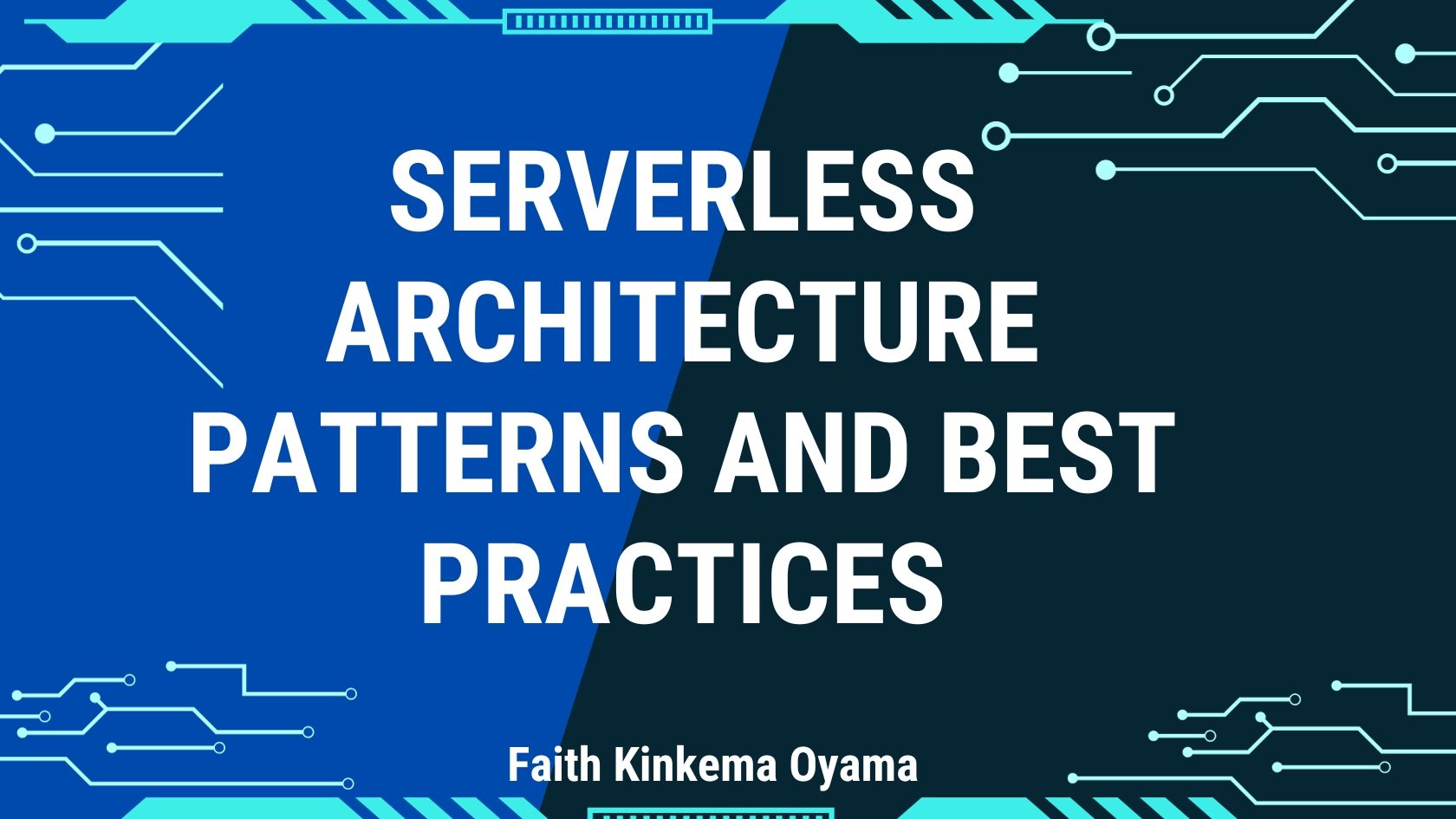Serverless architecture has become a hot topic in the developer world, and for good reason.
It promises a paradigm shift – one where we leave behind the burdens of server management and focus solely on building and deploying code. No more provisioning VMs, patching software, or scaling infrastructure manually.
In this article, we'll simplify the world of serverless, exploring its core principles and benefits. We'll see how serverless applications scale effortlessly, adapt to changing workloads, and potentially save you precious resources.
But, like any powerful tool, serverless comes with its considerations. We'll shed light on potential challenges like cold starts and vendor lock-in, empowering you to make informed decisions before embarking on your serverless journey.
This article aims to equip you with the knowledge and best practices to become a confident serverless developer. We'll break down complex concepts into clear, actionable steps, using real-world examples to illustrate key points. Whether you're a curious beginner or a seasoned developer looking to expand your skill set, this article will serve as your comprehensive guide to unlocking the potential of serverless architecture.
Common Serverless Architecture Patterns
Now that we've laid the groundwork for serverless, let's explore some practical ways to build your serverless applications. Buckle up, because we're entering the realm of patterns, and reusable designs that help you structure your code efficiently and leverage the strengths of serverless architecture.
API Gateway & Lambda: The Dynamic Duo
This is the classic serverless combo, like peanut butter and jelly for web APIs. Think of API Gateway as your friendly neighbourhood receptionist, greeting incoming requests from various sources (web browsers, mobile apps, and so on). With a polite nod, it then routes each request to the appropriate Lambda function (think processing data, sending emails, or updating databases).
It's a seamless partnership: the Gateway handles routing and security, while Lambda focuses on your application's specific logic.
Here are some perks of this pattern:
- Rapid Deployments: Get your APIs up and running quickly without worrying about server infrastructure.
- Scalability on Demand: Lambda functions automatically scale based on traffic, freeing you from manually adjusting server capacity.
- Pay-per-Use Pricing: You only pay for the resources your code uses, making serverless cost-effective for applications with fluctuating traffic.
But remember, even dynamic duos have their quirks. Cold starts, in which the initial invocation of a Lambda function takes longer to complete, can affect initial response times.
And while API Gateway offers strong security features, you still need to implement proper authorization and validation within your Lambda functions.
Fan-Out Pattern
Need to handle massive workloads but don't want to wait in line? Enter the Fan-Out pattern.
Imagine a single event (like a large file upload) triggering a swarm of Lambda functions working simultaneously on smaller chunks of the task. It's like having a team of chefs tackling different courses of a complex meal, making the entire process much faster.
This pattern excels in scenarios like:
- Image resizing: Break down a large image into smaller parts for parallel resizing, then stitch them back together for a fast and efficient outcome.
- Email sending: Send bulk emails to thousands of recipients without bogging down your system by distributing the task among multiple Lambda functions.
But remember that with great power comes great responsibility. Managing dependencies between your parallel functions and ensuring smooth data consistency can be tricky. Consider using queues or streams to coordinate their work and avoid unwanted surprises.
Messaging Pattern
Ever feel like your code components are tangled in a spaghetti dinner of dependencies? The Messaging pattern comes to the rescue, introducing a layer of calm, asynchronous communication between your serverless functions.
Instead of functions directly calling each other, they simply send messages to a queue (like a virtual mailbox). The functions responsible for processing those messages can pick them up at their own pace, decoupling them from the sender's execution time.
Think of it like leaving an order at a restaurant: tell the kitchen what you want (send a message), and then relax – your food will arrive (the message will be processed) when it's ready, without you needing to keep checking on the chef.
This approach offers several benefits:
- Agility: If one function fails, the message remains in the queue for later processing, preventing cascading failures.
- Scalability: Scale your message processing functions independently from the sending functions for optimal performance.
- Flexibility: Decoupled components are easier to maintain and update, making your application more agile.
But remember, choosing the right queueing service and managing message backlogs requires careful consideration. Make sure your messaging system can handle your application's expected workload and provides efficient message buffering to avoid bottlenecks.
Serverless Best Practices
Function Focus
Keep your Lambda functions small, focused, and stateless. Think of them as single-purpose spells: each should handle a specific task and avoid holding onto any persistent state. This improves their scalability and makes them easier to debug and maintain.
Error Handling
Nobody likes unexpected crashes. Handle errors within your functions and log them efficiently. Use tools like CloudWatch to monitor logs and proactively identify potential issues before they become full-blown serverless storms.
Observability is Key
You need tools to observe your serverless application's health and performance. Utilize monitoring services like Prometheus or Datadog to track metrics like execution time, memory usage, and invocations. Early detection of performance bottlenecks helps you optimize your functions and keep your costs in check.
Testing, Testing, 1, 2, 3
Don't send your functions into the serverless void untested! Rigorous unit and integration testing are crucial for catching bugs and ensuring your code behaves as expected. Frameworks like Jest and Serverless Framework can simplify your testing process and prevent unexpected serverless hiccups.
Cost Optimization
Remember, with great power comes great responsibility for your serverless wallet. Utilize cost-saving features like throttling, which limits function invocations per second, and timeouts, which automatically terminate long-running executions. Pay-per-use billing can be your friend, but only if you manage it wisely.
Security First
Don't let your serverless application fall to malicious attacks. Implement IAM roles and policies to control access to resources and functions. Use encryption for sensitive data and regularly review your security posture to ensure your serverless spells remain protected from dark magic.
Logging and Tracing
Enabling granular logging within your functions helps you troubleshoot issues and understand their execution flow. Use tracing tools like X-Ray to visualize the path of invocations across your serverless components, making debugging a breeze even in the most complex serverless landscapes.
Versioning and Deployment
Continuous improvement is key in the serverless world. Utilize CI/CD pipelines to automate build, test, and deployment processes for your functions. Versioning allows you to roll back to stable versions if needed and experiment with new features without impacting your live application.
Conclusion
Now, it's time to put to test your newfound knowledge and build incredible applications that scale with ease and cost less.
To always stay ahead of the curve, consider exploring these resources:
- AWS Serverless Application Model (SAM): Simplify building and deploying serverless applications on AWS.
- Serverless Framework: An open-source framework for building and deploying serverless applications across various cloud providers.
- Serverless Meetups and Conferences: Connect with other serverless enthusiasts and learn from the experts.
As you continue your serverless exploration, remember the golden rule: experiment, share your knowledge, and have fun. And if you ever encounter a particularly tricky serverless riddle, reach out! The serverless community is always eager to help.

